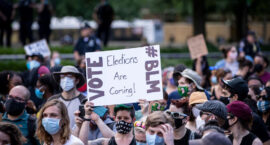
Ever since I could remember, the prevailing narrative about young people and elections has been that they don’t care and don’t vote. As a result, politicians have expressed no obligation to young people and their priorities. Yet, in August, as I watched the Democratic National Convention, I saw something different: Broadcasters and commentators referred to “the youth vote” as a meaningful voting bloc. For the first time, our political discourse was acknowledging the critical role young people have played in the last several elections.
Issues like climate change, reproductive justice, student debt, education and gun violence are life-and-death issues, with clear implications for young people’s daily experiences. Drawing from the work of foster care system and disability justice activists, young leaders rally for “Nothing about us without us.”
(This essay is part of a Women & Democracy multimedia package focused on Gen Z and student voters. The future envisioned by young leaders is bright—it’s built on reproductive rights, bodily autonomy, sustainability, freedom from violence and economic opportunity. Explore essays, a brand-new podcast, videos and more from some of your most loved [or soon to be!] influencers and writers, brought to you by Ms., DoSomething, the nonprofit that helps make volunteerism “cool,” and The Anthem Awards, the social impact arm of The Webbys.)











